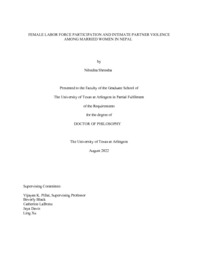| dc.description.abstract | Nepal has the highest rate of female labor force participation (FLFP) in South Asia (Ghosh, Singh, & Chigateri, 2017), alongside high levels of violence against women (Yoshikawa et al., 2014). The explanation for the co-occurrence of high levels of female labor force participation alongside significant amounts of intimate partner violence (IPV) has not been adequately explored. Studies on how the working status of a woman in Nepal makes her vulnerable to violence are few and far between (John, 2020). Theoretical models to account for this phenomenon are crucial to formulating interventions that are protective of working women. The current study aims to fill that gap and explore the risk of and protective factors against intimate partner violence among working women in Nepal.
Empirical studies of IPV among working women in Nepal have mostly been limited to two types of models: bargaining and male backlash. (John, 2020; Nwokolo, Shrestha, Ferguson, Shrestha, & Clark, 2020). The problem of endogeneity, a correlation between the explanatory variables and the error term in a regression, has not been explored and remains a methodological drawback confounding findings from prior studies on IPV among working women in Nepal. Given the limitations of current research on IPV among working women in Nepal, this study has three objectives. The first objective is to consider a more inclusive set of environmental factors, other than the immediate familial situation, that impinge on the working women’s intimate partner experiences. The second objective is to focus on the endogeneity problem as a methodological issue. The third objective is to run a statistical analysis on three cohorts (created by the duration of marriage till the survey) to account for the recall error that DHS data on violence could be subjected to.
The study used the Nepal Demographic and Health Survey, 2016, to analyze significant predictors of violence, along with the risk of and protective factors for married working women. The study found several significant predictors at macro, meso, and micro levels that influence the likelihood of domestic abuse. The predictors with the highest odds were the husband’s alcohol habits and the husband’s controlling nature. Women’s empowerment indicators, such as higher level of education, sole ownership of assets, a mobile phone, a bank account, and involvement in high-level professions, were found to be protective against all forms of violence. | |


